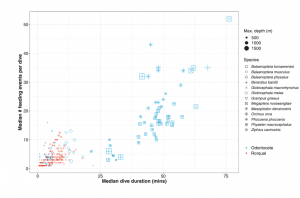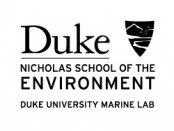
Ashley Marko, Hannah Folks, Dana Adcock, Madison Ding, Mara Turkieltaub Paredes
Overall Summary:
In a recent news article by Inside Science, Joshua Learn discusses the advantages and evolutionary history of gigantism as it relates to the largest of all cetaceans–whales. Whales have evolved a long way from the dog-sized organisms they were millions of years ago, he notes, and the limitations to marine gigantism were for many years obscure and unknown. In an effort to identify what limits the body size of these massive marine mammals, Learn introduces a critical research study by marine biologists J.A. Goldbogen and others at the Goldbogen Lab in Stanford. In this study, data was taken from multisensor devices, acoustic devices, and the stomach contents of beached whales in order to determine energy expenditure and intake during feeding. Through such collection and analysis, it was found that while the gigantism and overall body size of toothed whales were limited mainly by the body size of their prey, baleen whales were limited by the availability and temporality of their prey. That being said, Learn does conclude the article by discussing the possibility of seeing even larger whales in the far future.
Introduction:
From avoiding predation by smaller organisms to allowing for a more efficient metabolism, gigantism—very large body size—serves as an incredibly useful adaptation in most marine environments. However, the utility and advantage of gigantism become more nuanced and multi-faceted when it comes to whales. In fact, a recent news article by Inside Science shows that the evolutionary pathway for gigantism is split for rorqual and toothed whales—each group’s unique foraging strategies (filter-feeding, bio sonar-guided hunting on individual prey) spurred a propensity towards a large body size in order to better adapt to the spatial, temporal, and physiological characteristics of their prey and environment.
Background:
During the Oligocene, specialized foraging mechanisms likely led to the diversification of cetaceans. Odontocetes used biosonar-guided foraging to capture individual prey, while mysticetes used engulfment and lunge-propelled filter feeding. These differences in evolved behavior enabled separate pathways to gigantism, which had also evolved in order to promote greater metabolic and locomotion efficiency. For toothed whales, a bigger body size allows them to dive deeper, granting them the ability to catch a greater abundance of fish at lower water levels, rather than having to depend on populations that thrive on the near surface. The body size of baleen whales has evolved to improve their efficiency in catching abundant, yet patchily distributed small prey. These advantages are a direct result of the relationship between body size and respiratory functions. As body size increases, mass-specific oxygen storage is constant, while mass-specific oxygen usage decreases. Therefore, larger deep divers spend less energy while feeding for prey, making them more efficient predators than their smaller counterparts. Despite this, the energy toothed whales obtain from successful hunting does not outweigh the costs associated with a larger body size and the effort needed for deeper diving. Baleen whales, on the other hand, are relatively more efficient. Thanks to their filter-feeding foraging strategies and massive size, larger baleen whales perform fewer feeding events per dive and are able to engulf a greater biomass of prey, all at lower trophic levels than their deep diving counterparts. As such, rorquals are on average able to gain higher amounts of energy per feeding event.
Methods:
Learn highlights that the researchers studied foraging performance using multisensor tags. The data from these tags showed the largest odontocetes exhibited high feeding rates during long, deep dives. The energetic efficiency of the dive was determined mostly by the number of feeding events and the amount of energy obtained during each feeding event. The amount of energy obtained per feeding event was calculated from prey type and size distributions historically found in the stomachs of odontocetes and the acoustically measured biomass, density, and distribution of krill at rorqual foraging hotspots.


Results:
The results of the study demonstrate that larger odontocetes (toothed whales) appear to feed on larger prey relative to the size of the prey of its smaller counterparts. However, these prey were not disproportionately larger, and smaller toothed whales fed more frequently. Therefore, the energy obtained from prey didn’t quite outweigh the increased costs of having a larger body size or undergoing deeper dives, which means there is actually a decrease in energetic efficiency observed with increasing body size in odontocetes.
However, in the case of rorquals (largest group of baleen whales), the measured distribution and density of krill biomass suggest that larger rorquals are not limited by the size of their prey on individual dives. In fact, baleens experience more rapid increases in energy from their prey along with increasing body size, as larger rorquals have larger capacities for engulfment. Rorquals also have the ability to maneuver more than their toothed counterparts, and increase feeding rates per dive when krill density is higher, indicating that their energy efficiency would increase in conjunction with their body size. These results were robust to assumptions about trait similarity from shared ancestry as well as the scaling of each group’s metabolic rates. This implies that it is evolutionarily advantageous for rorqual whales to increase in body size. Because of this, provided the availability of its prey can keep up, these whales could get bigger.
Conclusion:
Gigantism in cetaceans has many benefits, including energy storage for more efficient and prolonged migration as well as granting the ability to better retain heat, making these animals incredibly productive predators. Whales are perhaps some of the most recognizable marine megafauna and vary widely in size across species, leading scientists to question the differing limitations between groups. Goldbogen et al. found that prey availability is the primary restriction on marine gigantism in whales. For toothed whales, a higher abundance of larger prey could make them even more massive, and the same goes for baleen whales, whose prey consists of small krill with variable availability and concentration throughout the year. In the past 50 million years, whales have nearly grown 10,000 times larger, and depending on the future availability and temporality of their prey, Goldbogen believes they could get even larger.
Significance and Future Studies:
Gigantism is a particularly interesting adaptation in an ecological and environmental context given our current battle against climate change. Although their large body size allows for these massive creatures to act as the efficient and successful predators they are, the issue of commercial overfishing is utterly devastating to cetacean populations. Historically, the overall body size of many whale species has been decreasing, and now that we know how prey abundance and body size affects the body size of whales, a direct correlation between these events is clear. This news article and study give us further insight on the ecosystem dynamics and evolutionary history behind gigantism and how both top-down and bottom-up interactions yield a balanced yet fragile food web. Future research should focus on how physical changes in an ecosystem (such as temperature, oxygen availability, and turbidity) can affect prey populations and marine gigantism, which inherently impact predator-prey dynamics. Furthermore, future studies could focus upon marine gigantism in other endothermic and exothermic species, relating the similarities and differences in limitations on body size against cetaceans.
News Article:
https://www.insidescience.org/news/how-whales-got-so-large-and-why-they-aren%E2%80%99t-even-bigger
Scientific Study/Article:
https://science-sciencemag-org.proxy.lib.duke.edu/content/sci/366/6471/1367.full.pdf
References
Arnold, Carrie. 2018. “Why Do Whales Get So Big? Science May Have an Answer.” National
Geographic, 26 Mar. 2018, nationalgeographic.com/news/2018/03/whales-size-animals- ocean-marine-mammals/.
Goldbogen, J. A. et al. (2019). Why whales are big but not bigger: Physiological drivers and
ecological limits in the age of ocean giants. Science, 366(6471), 1367–1372. doi: 10.1126/science.aax9044
Learn, Joshua. 2019. “How Whales Got So Large — And Why They Aren’t Even Bigger.” Inside
Science, 12 Dec. 2019, insidescience.org/news/how-whales-got-so-large-and-why-they-
aren%E2%80%99t -even-bigger.
Williams, T. M. (2019). The Biology of Big. Science, 366(6471), 1316–1317. doi:
10.1126/science.aba1128
Yong, Ed. 2018. “Why Whales Got So Big” The Atlantic, 4 Apr. 2018,
theatlantic.com/science/archive/2018/04/why-whales-got-so-big/557213/.



3 responses to “Whales and Marine Gigantism”